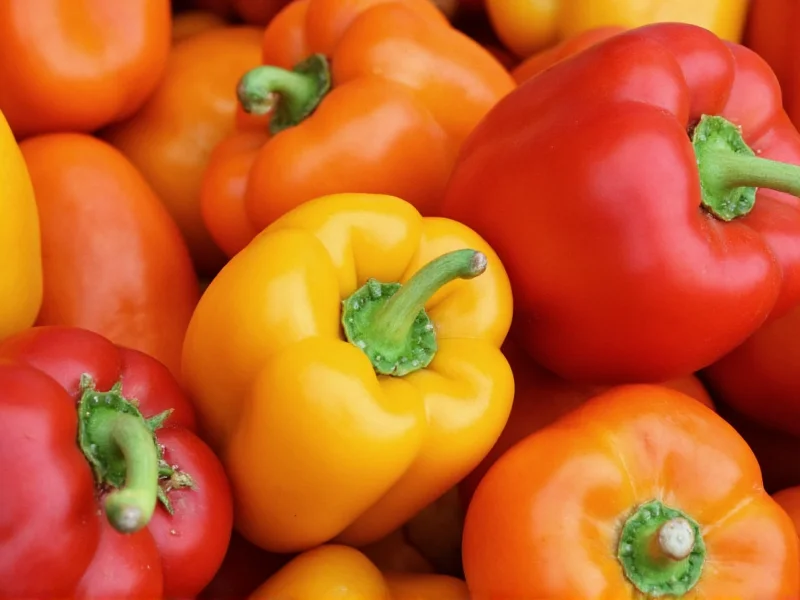When exploring which bell pepper variety is the sweetest, gardeners and culinary enthusiasts consistently find yellow bell peppers at the top of sweetness charts. The sweetness difference stems from ripeness progression and biochemical composition. As bell peppers mature from green to their final color, they convert starches to sugars, with yellow varieties reaching peak sugar concentration before developing into orange or red.
The Science Behind Bell Pepper Sweetness
Bell pepper sweetness isn't measured on the Scoville scale (which applies to hot peppers) but rather through sugar content analysis and sensory evaluation. Unlike their spicy relatives, bell peppers contain zero capsaicin—the compound responsible for heat in chili peppers. Instead, their flavor profile depends on:
- Natural sugar concentration (primarily glucose and fructose)
- Vitamin C content (which affects perceived freshness)
- Carotenoid development (pigments that influence flavor compounds)
- Ripeness stage at harvest
Research from agricultural universities confirms that yellow bell peppers typically register between 8-10% sugar content, making them noticeably sweeter than other common varieties. This sweetness develops as chlorophyll breaks down during ripening, allowing carotenoids to dominate while sugars accumulate.
Comparing Sweetness Across Bell Pepper Varieties
Understanding the bell pepper color and sweetness relationship helps explain why yellow varieties reign supreme in sweetness. The ripening process follows a predictable pattern that directly impacts flavor:
| Bell Pepper Color | Sugar Content | Ripeness Stage | Flavor Profile |
|---|---|---|---|
| Yellow | 8-10% | Intermediate | Bright, fruity, noticeably sweet |
| Orange | 7-9% | Intermediate | Sweet with citrus notes |
| Red | 6-8% | Most mature | Rich, full-bodied, moderately sweet |
| Green | 4-6% | Least mature | Grassy, slightly bitter, least sweet |
| Purple/Chocolate | 5-7% | Specialty varieties | Earthy with moderate sweetness |
Why Yellow Bell Peppers Win the Sweetness Contest
The yellow bell peppers sweetness level surpasses other varieties due to their specific position in the ripening continuum. When bell peppers transition from green to yellow, they've developed sufficient sugar content without the additional compounds that develop in later stages. Red peppers, while nutritionally superior with higher vitamin content, develop more complex flavor compounds that balance sweetness with earthiness.
Agricultural studies show that yellow bell peppers reach their peak sugar concentration approximately 15-20 days after turning from green. This intermediate ripeness stage creates the optimal sugar-to-acid ratio that our taste buds perceive as maximum sweetness. Orange varieties follow closely behind, while red peppers develop additional flavor compounds that temper their sweetness.
Factors That Influence Bell Pepper Sweetness
While color provides a reliable indicator, several factors affect the actual sweetness you'll experience with comparing sweet bell pepper varieties:
Ripeness at Harvest
Commercially grown peppers are often harvested before peak sweetness to withstand transportation. Locally grown or vine-ripened peppers typically deliver superior sweetness. The longer peppers stay on the plant, the higher their sugar content becomes—up to a point.
Growing Conditions
Sun exposure, soil quality, and watering practices significantly impact sugar development. Peppers grown in warm, sunny conditions with consistent moisture develop higher sugar content. Stress factors like drought can actually increase sweetness as the plant concentrates sugars.
Storage Methods
Refrigeration slows but doesn't stop the ripening process. Storing bell peppers at room temperature for 2-3 days can enhance sweetness as starches continue converting to sugars. However, extended storage leads to moisture loss and flavor degradation.
Culinary Applications for Sweet Bell Peppers
Knowing why are yellow bell peppers sweeter helps determine their best culinary uses. Their pronounced sweetness makes them ideal for:
- Raw applications like salads and crudités where sweetness shines
- Roasting and caramelizing (the Maillard reaction enhances natural sugars)
- Filling with savory ingredients where contrast is desirable
- Blending into sauces and soups for natural sweetness
- Grilling alongside other vegetables
For dishes requiring subtle sweetness, orange bell peppers offer a middle ground. Red peppers work better when you want richer flavor complexity, while green peppers provide necessary bitterness in certain recipes. Understanding these distinctions helps you select the perfect pepper for your culinary needs.
Common Misconceptions About Bell Pepper Sweetness
Several myths persist about sweetest bell pepper for cooking. Many believe red peppers are sweetest because they're fully ripe, but this confuses nutritional maturity with sugar concentration. Others think all yellow varieties are identical, when in fact specific cultivars like 'Golden Bell' or 'Sunrise' have been bred specifically for enhanced sweetness.
Another misconception is that larger peppers are sweeter. Size correlates more with water content than sugar concentration. The thickest-walled peppers often have the best flavor balance, but wall thickness doesn't directly determine sweetness.











 浙公网安备
33010002000092号
浙公网安备
33010002000092号 浙B2-20120091-4
浙B2-20120091-4